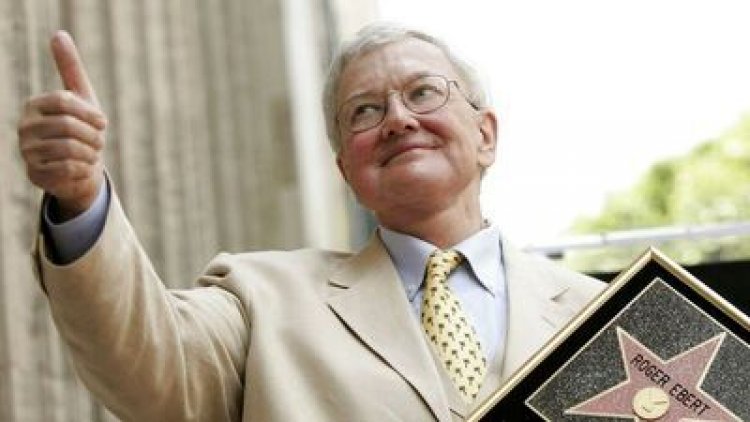Two Thumbs Up to Roger Ebert and the Movies
Did you know that "Two Thumbs Up" was not part of our lexicon until it was coined by my late husband Roger Ebert to be used as a rating system for movies with his pal and television partner Gene Siskel on their popular movie review show? Dating back to the Roman Gladiators, when you wanted to use digits to express pleasure or displeasure, it was with one thumb only, whether up or down. It took two beloved film critics from Chicago to marshal in a whole new way of rating experiences. They say that necessity is the mother of invention, and it was necessary for Roger and Gene to take a new rating system with them when they left one platform for another (from Public television WTTW to Tribune Broadcasting to Buena Vista Television at Disney, back to WTTW). They were wise enough to trademark the use of thumbs for movies and those trademarks are still owned by their estates and in use at RogerEbert.com. So when you hear the the phrase "Two Thumbs Up" as a way of expressing extreme pleasure even for things other than movies, you can thank Roger and Gene. The irony of the whole thing is that Roger didn't really like rating movies. He told me that he was open minded and that generally when he walked into a Screening Room or movie theater, he was hoping to see a good movie. The experience did not always bear this out, thus two of his most popular books were I Hated, Hated, Hated This Movie and Your Movie Sucks. The irony of those titles being so popular is that Roger was also the model for Empathy, and one of the most kind-hearted persons I ever met. "Movies are a machine that generates empathy," he would say, "the purpose of civilization and growth is to be able to reach out and empathize a little bit with other people. And for me, the movies... let you understand a little bit more about different hopes, aspirations, dreams and fears. It helps us to identify with the people who are sharing this journey with us." And today, April 4th, on the ninth anniversary of his transition from this earth, that is what stands out the most about him to me. In the Lars Von Trier film, "Breaking the Waves," the protagonist's husband, played by Stellan Skarsgård, is testifying at her trial about her character and about whether she was in fact, insane. When asked to describe her, he said simply, "Good...she was good." That one word also describes Roger. I was fortunate to witness that authentic goodness firsthand in the almost 24 years we were together. But even I discovered greater depths of goodness when people from all over wrote to me or stopped me on the streets to tell me of some kindness in word or deed he had done for them. When did he find the time to do all of this? And why? What drove his deep-seated goodness and his empathy and kindness? We may never know the whole of it, just like we can never know the whole of anything or anyone, including ourselves. But for purposes of this website, let's just start with a tribute to his writing, to which we give Two Thumbs Up. To commemorate the ninth anniversary of Roger's "leave of presence," we will be republishing all throughout April some of his most cherished reviews and essays handpicked by critics, filmmakers, academics and other distinguished readers of this site. It was on April 3rd, 1967, as Roger noted in his final article, "A Leave of Presence," that he became a critic for the Chicago Sun-Times, and on that same day in 2013, he thanked his loyal readers around the world for their support and impassioned discourse. "So on this day of reflection I say again, thank you for going on this journey with me," he wrote. "I'll see you at the movies." A day later, Roger passed away at age 70, leaving behind an extraordinary legacy of timeless analyses that remain a crucial voice in modern film criticism. As a preview of this month, here are some thoughts shared by a few writers regarding their favorite work of Roger's. Today we will print only parts of their comments, but starting tomorrow we will publish the comments followed by Roger's reviews. Let's begin with former Philadelphia Inquirer critic Carrie Rickey, who wrote, "I particularly liked all of Roger's writing about elevation. He was writing on the subject at about the time I left the Inquirer and was in a kind of withdrawal from watching 6 to 10 films a week. It made me look with a critical eye at the somatic effect movies (and music and other visual art) have on viewers." Film critic Robert Daniels writes, "My favorite review from Roger is of 'Cloud Atlas.' Of course, I love 'Cloud Atlas.' So it should surprise no one that I chose this sweeping epic. I also believe this review by Roger is as exceptional as the film. I think some critics make the mistake of believing they must have an answer, or should be ready to explain a film. But I find Roger's ability to appreciate 'Cloud Atlas' through what he doesn't know, and how he doesn't know it, as not only a great formal exercise, but a refreshing edge of humility and intel


Did you know that "Two Thumbs Up" was not part of our lexicon until it was coined by my late husband Roger Ebert to be used as a rating system for movies with his pal and television partner Gene Siskel on their popular movie review show? Dating back to the Roman Gladiators, when you wanted to use digits to express pleasure or displeasure, it was with one thumb only, whether up or down. It took two beloved film critics from Chicago to marshal in a whole new way of rating experiences. They say that necessity is the mother of invention, and it was necessary for Roger and Gene to take a new rating system with them when they left one platform for another (from Public television WTTW to Tribune Broadcasting to Buena Vista Television at Disney, back to WTTW).
They were wise enough to trademark the use of thumbs for movies and those trademarks are still owned by their estates and in use at RogerEbert.com. So when you hear the the phrase "Two Thumbs Up" as a way of expressing extreme pleasure even for things other than movies, you can thank Roger and Gene. The irony of the whole thing is that Roger didn't really like rating movies. He told me that he was open minded and that generally when he walked into a Screening Room or movie theater, he was hoping to see a good movie. The experience did not always bear this out, thus two of his most popular books were I Hated, Hated, Hated This Movie and Your Movie Sucks. The irony of those titles being so popular is that Roger was also the model for Empathy, and one of the most kind-hearted persons I ever met.
"Movies are a machine that generates empathy," he would say, "the purpose of civilization and growth is to be able to reach out and empathize a little bit with other people. And for me, the movies... let you understand a little bit more about different hopes, aspirations, dreams and fears. It helps us to identify with the people who are sharing this journey with us." And today, April 4th, on the ninth anniversary of his transition from this earth, that is what stands out the most about him to me.
In the Lars Von Trier film, "Breaking the Waves," the protagonist's husband, played by Stellan Skarsgård, is testifying at her trial about her character and about whether she was in fact, insane. When asked to describe her, he said simply, "Good...she was good." That one word also describes Roger. I was fortunate to witness that authentic goodness firsthand in the almost 24 years we were together. But even I discovered greater depths of goodness when people from all over wrote to me or stopped me on the streets to tell me of some kindness in word or deed he had done for them. When did he find the time to do all of this? And why? What drove his deep-seated goodness and his empathy and kindness? We may never know the whole of it, just like we can never know the whole of anything or anyone, including ourselves. But for purposes of this website, let's just start with a tribute to his writing, to which we give Two Thumbs Up.
To commemorate the ninth anniversary of Roger's "leave of presence," we will be republishing all throughout April some of his most cherished reviews and essays handpicked by critics, filmmakers, academics and other distinguished readers of this site. It was on April 3rd, 1967, as Roger noted in his final article, "A Leave of Presence," that he became a critic for the Chicago Sun-Times, and on that same day in 2013, he thanked his loyal readers around the world for their support and impassioned discourse. "So on this day of reflection I say again, thank you for going on this journey with me," he wrote. "I'll see you at the movies." A day later, Roger passed away at age 70, leaving behind an extraordinary legacy of timeless analyses that remain a crucial voice in modern film criticism.
As a preview of this month, here are some thoughts shared by a few writers regarding their favorite work of Roger's. Today we will print only parts of their comments, but starting tomorrow we will publish the comments followed by Roger's reviews. Let's begin with former Philadelphia Inquirer critic Carrie Rickey, who wrote, "I particularly liked all of Roger's writing about elevation. He was writing on the subject at about the time I left the Inquirer and was in a kind of withdrawal from watching 6 to 10 films a week. It made me look with a critical eye at the somatic effect movies (and music and other visual art) have on viewers."

Film critic Robert Daniels writes, "My favorite review from Roger is of 'Cloud Atlas.' Of course, I love 'Cloud Atlas.' So it should surprise no one that I chose this sweeping epic. I also believe this review by Roger is as exceptional as the film. I think some critics make the mistake of believing they must have an answer, or should be ready to explain a film. But I find Roger's ability to appreciate 'Cloud Atlas' through what he doesn't know, and how he doesn't know it, as not only a great formal exercise, but a refreshing edge of humility and intellectual vulnerability that more critics should lean on. While film is a machine for empathy, said empathy only comes from both not only an emotional vulnerability, but an intellectual one too. This review is quintessentially both."

According to our frequent contributor Marya E. Gates, "The review that I always return to is his review of "Only You." It's so lovely and emotional and takes the film on its own terms. The very last line has stuck with me for decades. I read it when I need a pick me up." Here are the final words of the review: "Norman Jewison, who directs 'Only You' with a light, smiling touch, began his directing career just as movies like this were going out of style. He directed Doris Day in 'The Thrill of It All' (1963), co-starring James Garner, and in 'Send Me No Flowers' (1964), with Rock Hudson, and I hope Marisa Tomei understands it is a compliment when I say that in 'Only You' she has some of Doris Day's sunny warmth. I suppose Doris Day is out of fashion, and so are movies like 'Only You,' but just because something is not done anymore doesn't mean it's not worth doing."

Our Far Flung Correspondent from Brazil, Pablo Villaca, one of the film critics we met online whose works we so admired that we began publishing them on our site, writes: "'By its eternity I measure my time', Roger wrote about 'La Dolce Vita'. That sentence by itself tells us what a masterful writer he was. He didn't need long words or long sentences to convey complex thoughts and feelings. With one more word than the mythic six that Hemingway posited in his famous challenge, Roger told us the story of his life and the importance of Art itself. What made Roger so powerful as a writer, however, was not merely his talent, but his immense sensibility and his unparalleled humanity. He understood how a picture could tell us different stories and make us understand deep changes within ourselves even if the movie itself never changed at all. Marcello was always the same mirror and, in a sense, the reflex in its surface was always the same - it was Roger who kept changing, maturing, growing as a human being and, as result, seeing his reflection under new lights and in new positions."

As for another cherished contributor, Donald Liebenson, his favorite Roger review evokes memories of another April month from the past. "Of the two new films released on the weekend of April 15, 1983, 'Lone Wolf McQuaid' starring Chuck Norris topped 'Flashdance' at the box office," he wrote. "I'll repeat that: 'Lone Wolf McQuaid' topped 'Flashdance' at the box office. Meanwhile, in Chicago, 'Local Hero' opened on one screen at Water Tower Place. It took roughly two months before it had made its way to Chicago. Its star, Peter Reigert, is no Chuck Norris when it comes to putting asses in the seats. But Roger's four-star review compelled me to give Bill Forsyth's whimsical village comedy a go. Roger had me at, 'Here is a small film to treasure, a loving, funny, understated portrait of a small Scottish town and its encounter with a giant oil company.'
One of the most exhilarating experiences a filmgoer can have is to be so lifted and transported by a film that they rush out of the theater, seek out a pay phone (this was 1983, remember) and start excitedly calling people to tell them they have to see this film. And so it was (and is) with me and "Local Hero." It exemplifies what made Roger a thumb above as a film critic: He championed art house and independent cinema; giving those films equal measure in print and on 'Siskel & Ebert.' That was prime real estate, and artists such as Wallace Shawn, John Dahl and John Sayles must have thanked the movie gods for the exposure Roger gave 'My Dinner with Andre,' 'Red Rock West' and 'Return of the Secaucus Seven,' respectively. So many films I might never have found had not Roger pointed the way. "Local Hero" was the dearest discovery."

At Literary Hub, Beth Parker recounted her 14-month-long "communication" with Roger, writing, "Of all the relationships that waxed and waned during the heart of the pandemic, one person I didn’t expect to create a meaningful friendship with was a dead movie critic. I work in the book industry, and one of my early acquisitions from the 'free bookshelf' at Random House was The Great Movies (Volume 1) by Roger Ebert. A surefire way to get me to my favorite theater, Film Forum, was when they were playing an old 'Ebert Movie.' There, I watched films that I may not have otherwise sought out: "Days of Heaven," "The Life and Death of Colonel Blimp" and "Kind Hearts and Coronets.' When an Ebert Movie showed at Film Forum, I’d make a point to go see it, read the writeup from the book, and check off the title in the table of contents. Gradually, I came into possession of all four volumes, and I’d look over the lists from time to time, cross-referencing with theater listings. But when everything shut down in March 2020, the volumes of The Great Movies took on more significance. I wasn’t joining the sourdough movement, but what if I could watch every movie in these books? Suddenly, I had a project." You can read the rest of Beth's essay here.

















:quality(85):upscale()/2025/02/27/808/n/1922398/26784cf967c0adcd4c0950.54527747_.jpg)


